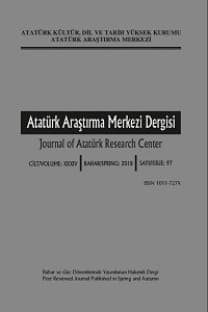Mütareke Başlarında 2.Ordu' nun Konya'ya Nakli ve Ortaya Çıkan Sorunlar
I. Dünya Savaşı’nın sonlarında Osmanh Devleti’nin, Güney Cephesinde 2., 3. ve 7. Ordu ile bu orduların bağlı bulunduğu Yıldırım Orduları Grubu bulunuyordu. 2. Ordu’nun Komutanı Nihat (Anılmış) Paşa, 7. Ordu Komutanı da 7 Ağustos 1918 tarihinden itibaren Mustafa Kemal idi. Her iki ordunun da bağlı olduğunu söylediğimiz Yıldırım Orduları Grubu Komutanı ise Liman von Sanders’ti. Fakat Osmanlı Devleti 30 Ekim 1918 tarihinde askerî ve siyasî bakımdan çok ağır maddeler içeren Mondros Mütarekesi' ni imzaladı. Mütareke’nin askerî hükümleri gereğince Osmanlı ordusunun çeşitli kademelerinde bulunan Alman subay ve generallerinin Türkiye’den ayrılmaları gerekiyordu. İşte mütarekedeki bu hüküm gereğince, Yıldırım Orduları Grubu Komutanı olan Alman Genaral Liman von Sanders, görevini 7. Ordu Komutanı Mustafa Kemal’e 31 Ekim 1918 tarihinde Adana’da devretti
Anahtar Kelimeler:
Mütareke yılları, 1.Dünya Savaşı, 2.Ordu
Transfer of the 2nd Army to Konya at the Beginning of the Armistice and Emerging Problems
At the end of the First World War, there were the 2nd, 3rd and 7th Army of the Osmanh State on the Southern Front and the Lightning Armies Group that these armies were affiliated with. The Commander of the 2nd Army was Nihat (Anılı) Pasha, and the 7th Army Commander was Mustafa Kemal from 7 August 1918 The Commander of the Lightning Armies Group Commander, whom we said was connected to both armies, was Liman von Sanders. However, the Ottoman State signed the Mondros Armistice on 30 October 1918, which contained very heavy military and political items. Located in various stages of the Ottoman army in accordance with the provisions of the Armistice he had to leave the German military officers and generals from Turkey. As per this provision in the armistice, German Genaral Liman von Sanders, the Commander of the Lightning Armies Group, handed over his duty to the 7th Army Commander Mustafa Kemal in Adana on October 31, 1918.
Keywords:
The years of armistice, I. World War, 2. Army,
___
- Genelkurmay Askerî Tarih ve Stratejik Etüt Başk. Klasör. 239 Dosya, 12-21 Fihrist, 7
- Fahreddin Altay, On Yıl Savaş ve Sonrası (1912-1922), İst, 1970, s. 79.
- ISSN: 1011-727X
- Yayın Aralığı: Yılda 2 Sayı
- Başlangıç: 1984
- Yayıncı: Atatürk Kültür, Dil ve Tarih Yüksek Kurumu Atatürk Araştırma Merkezi
Sayıdaki Diğer Makaleler
1921 Tarihli Türk-Fransız Anlaşması'nın Hazırlık Aşamaları
Zonguldak ve Havalisinde Milli Mücadele'ye Zarar Verici Faaliyetler
Mütareke Başlarında 2.Ordu' nun Konya'ya Nakli ve Ortaya Çıkan Sorunlar
Atatürk Döneminde Kadın Eğitimi
Kurtuluş Savaşı'nda Savaş Sanayii
Fiedler'in Durumsal Önderlik Modeli Açısından Atatürk'ün Önderliğinin Değerlendirilmesi
